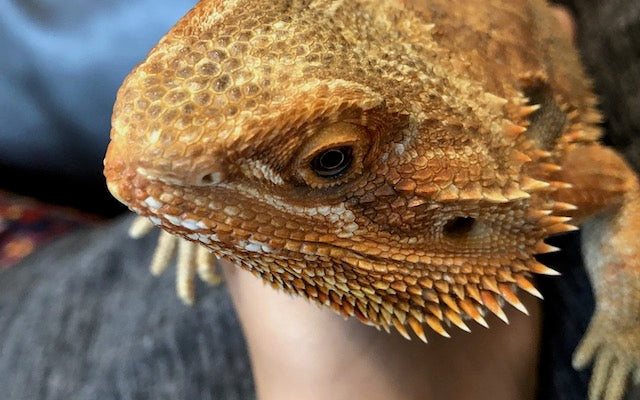When considering a new pet, it may be obvious how you or your children would bond with a dog, a cat, or even a hamster. But a bearded dragon? How do you bond with a bearded dragon?
Bearded dragons aren’t soft and cuddly; they won’t give you an effusive display of affection the way puppies will. But bearded dragons can form meaningful bonds with their human companions. Knowing how to bond with your bearded dragon is an important part of welcoming them into your home and creating a happy life for them.
Do Bearded Dragons Bond with Their Owners?
Yes! While not effusive and certainly not as emotional as dogs, cats, and other mammals, bearded dragons are known to show signs of affection to their owners. For example, they will remain calm when handled or sit still on their owner’s lap.
Bearded dragons are not social creatures by nature. In the wild, they live alone. So they won’t bond with other bearded dragons (and shouldn’t be kept in the same terrarium if you own more than one). But they can grow to enjoy the companionship of their human friends if you treat them well.
In part, this is because they learn to associate you with delicious food. They also come to realize that you are not a predator, which helps remove some of the initial stress they might experience when you first bring them home.
Can Bearded Dragons Feel Love?
No, bearded dragons cannot feel love. This is because bearded dragons have an underdeveloped hypothalamus. The hypothalamus is the part of the brain that regulates hormones and emotions.
Mammals have a more developed hypothalamus, which is why they experience complex emotions such as affection, loyalty, and even jealousy. Bearded dragons can only experience the basic emotions of fear, aggression, and pleasure. Your bearded dragon may enjoy the simple pleasure of being with you, as they have come to associate you with providing food and care, but they can’t love you in the sense that you can love them.
This doesn’t mean your dragon won’t act in ways that appear affectionate. Many bearded dragons recognize their owner’s voice and scent, and display various signs of comfort and familiarity around them. This can foster a really special bond even though it isn’t technically love.
How Do You Know If Your Bearded Dragon Likes You?
How do you know if your bearded dragon likes you, or at least trusts you?
When you ask this question, keep in mind that each dragon does have a distinct personality. This will affect how comfortable they are around people.
Here are some ways you can tell if your dragon likes you (or is comfortable with you, at least!).
Your dragon…
- Shows recognition and excitement when you come near their terrarium
- Sits still on your lap for at least a little while
- Falls asleep on your lap or near you
- Watches TV with you (yes! Bearded dragons actually enjoy this! It’s a great way to bond with them)
- Comes willingly when you put your hand into the terrarium, with or without food
- Looks for you when they are stressed or scared

How to Bond with Your Bearded Dragon: Tips & Tricks
The goal of bonding with your dragon is to get them familiar with you and comfortable around you so you can interact and spend time together.
A healthy bond between you and your pet can enhance your life and theirs.
Here are some ways to achieve that:
- Feed by hand gently. You can use tweezers for an insect or just your hands for veggies and fruit. Of course, you shouldn’t attempt to do this if your dragon is puffing out their beard or showing signs of hostility. (Bearded dragons don’t often bite, but they might if they are aggravated.)
- Pick them up slowly and gently. Make sure your hand is in their line of vision. Don’t grab your dragon from above or at an angle where they can’t see you coming. They will think you’re a predator, which will scare them and possibly cause them to bite.
- Is your dragon new? Wait a couple weeks before handling them at all so they can get used to you.
- Spend time with your pet! Here are fun ways to do it:
- Take your dragon for a walk.
- Cuddle with and gently stroke your dragon. (Always wash your hands thoroughly after!)
- Play ball with your dragon by rolling a ball around and gauging their interest. Some dragons will nudge the ball or go after it. (Just make sure the ball is bigger than the space between your dragon’s eyes to avoid a choking hazard.)
- Give your dragon a bath or let them swim if they enjoy being in the water.
Pro Tip: If the bearded dragon belongs to your child or there are children who will be handling your pet, make sure you explain to them why it’s important to be gentle, slow, and not make any surprising moves. Tell them what to expect and show them how to handle your dragon properly. The same applies to visitors or anyone who will be pet-sitting for you.
Here are some (obvious) things you should NOT do or you risk ruining the bond with your bearded dragon. These all boil down to basic care and commitment to giving your pet a loving home.
- Mishandling (such as picking up by the tail)
- Exposure to loud noises (such as blaring music or TV)
- Consistently startling them
- Picking them up when they don’t want to be handled
- Teasing them
- Improper care
How to Get Your Bearded Dragon to Like You
There are a few tips you can keep in mind as you work on developing a bond with your dragon:
- Know their personality. One of the most important things to do as a responsible bearded dragon owner is to understand your beardie’s personality. Read cues such as when they clearly don’t want to be handled.
- Remember their wild side. At the end of the day, bearded dragons are prey animals and can be easily startled. It’s important to remember this, as it explains a lot of their behavior and can help you approach them in a way that allows them to feel safe and secure.
- Give new dragons space. When you first bring a dragon home, it’s usually best to wait about two weeks until you handle your pet so they have time to get used to their new environment before they also get used to being handled. Also note that if your dragon is a rescue, they may need even more time to adjust.
- Get them used to you. At first, you can leave a piece of clothing in their tank so they can get used to your scent. Then you can simply hold your hand in the tank for a few moments at a time so they get used to your presence. Eventually you will be able to feed them by hand; move slowly and steadily, and make sure they can see you approaching.
How to Safely Handle Your Bearded Dragon
Here are some tips and things to keep in mind so you can handle your dragon safely:
- Don’t make any quick or sudden movements; make sure you are in your dragon’s eyeline when you go to pick them up.
- Place your hand beneath your dragon’s belly.
- Support all four of their legs; don’t let any limbs dangle or they’ll feel unstable and insecure.
- Bearded dragons do have claws, so be aware they may scratch you a bit unintentionally when you pick them up.
- Never hold them by the tail!
- Pet them in the direction of their scales, never against their scales.
- Don’t pull scales if they are shedding.
- Wash your hands very thoroughly after handling your dragon to prevent salmonella.
- Don’t touch your face or mouth while handling your dragon.
Takeaway: If you handle your dragon gently, get to know their individual quirks and preferences, and treat them with care, you can build a strong bond with your pet.
How do you bond with your bearded dragon? Do you have any questions or feedback for us? Email us at team@dragonsdiet.com








